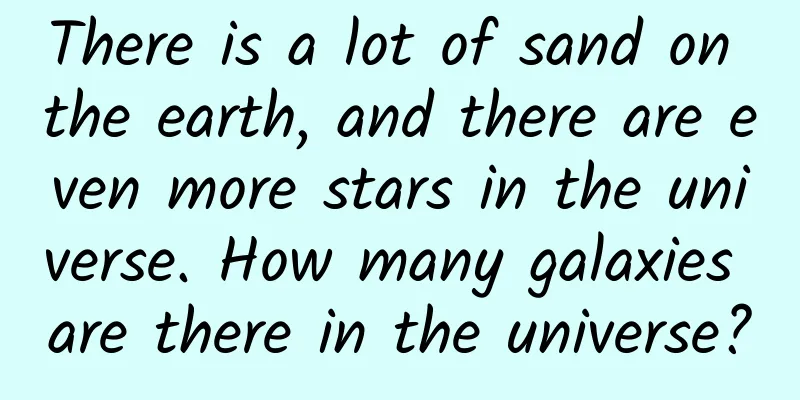There is a lot of sand on the earth, and there are even more stars in the universe. How many galaxies are there in the universe?

|
How much sand is there on Earth? This is a question that cannot be accurately counted, but each cubic centimeter can hold about 8,000 grains of sand. In this way, each cubic meter can hold 8 billion grains of sand, and the final result must be an astronomical figure. However, although there is a lot of sand on the earth, there are not as many as the stars in the universe. What is a star? The sun is a star. There is only one star in our solar system, so we feel that this thing is very rare, but in fact, most of the stars we see in the night sky are stars. If we look at the entire universe, the number of stars will be too many to count, far more than the grains of sand on the earth. However, celestial bodies in the universe are much more regular than grains of sand. They do not exist in isolation. Because of the gravitational force between each other, celestial bodies will form systems of various sizes, and the most basic system among them is the galaxy. What is a galaxy? Our solar system cannot be considered a galaxy, it is just a star system. From our perspective, the solar system is very large. This "huge" star system has a star, 8 planets, 173 satellites of planets, and a large number of dwarf planets, asteroids, and other celestial bodies. But such a "huge" star system is just a speck of dust in the Milky Way, because there are hundreds of billions of stars in the Milky Way, and among these stars there are some very large guys, whose mass can reach hundreds of times the mass of the sun. So, how big is such a galaxy with hundreds of billions of stars? Its diameter is about 150,000 light-years, and our solar system is about 26,000 light-years away from the center of the Milky Way. The Milky Way is a very large cosmic structure, but such large cosmic structures are not uncommon in the universe. Not to mention the ones far away, there is a galaxy even larger than the Milky Way right near the Milky Way. We call it the Andromeda Galaxy. It is the closest galaxy to us outside the Milky Way. It is about 2.54 million light years away from us, which means that it takes 2.54 million years for its light to reach the Earth. The Andromeda Galaxy we see now is what it looked like 2.54 million years ago. There are dozens of galaxies of all sizes around the Milky Way and the Andromeda Galaxy. These galaxies form a larger celestial system, a galaxy group, which we call the Local Group. The diameter of a galaxy reaches tens of thousands or even hundreds of thousands of light years, and the distance between galaxies is calculated in "millions of light years". It goes without saying how huge the Local Group, which consists of nearly 50 galaxies, is. However, "galaxy clusters" are not rare in the universe. There are even larger celestial structures above them, which we call "superclusters". A supercluster is usually composed of hundreds of galaxy clusters. For example, the supercluster we are in is composed of more than 100 galaxy clusters. We call this supercluster the "Virgo Supercluster". The Virgo Supercluster is not a roughly circular structure, but rather an obvious ellipse. Its long diameter reaches 100 million to 200 million light years, and the number of galaxies in it is as many as 2,500 or more. Hundreds of millions of light years is an unattainable distance for us, but to the universe, such a celestial structure is just a speck of dust. If the entire observable universe is represented by an A4 paper, then a small dot at the center of the paper can roughly represent the Virgo Supercluster. The radius of the observable universe is about 46.5 billion light years, so how many galaxies are there in the observable universe? We are not yet able to get accurate data, but scientists estimate that in such a huge range, there can be at most 2 trillion galaxies, and at least no less than 200 billion. With so many galaxies, and each galaxy has hundreds of billions of stars, it seems that there are indeed more stars in the universe than grains of sand on Earth. We have already appreciated how huge the universe is, but this is only the observable universe. The radius of the observable universe is 46.5 billion light years. Because of the speed of light and the expansion of the universe, we can only see things within this range. Outside the observable universe, there is a much wider space, and the space there is still expanding. So how big the universe is, how many galaxies there are, and how many stars there are, no one knows, and it is very likely that no one will ever know. The size of the universe not only exceeds our imagination, but also exceeds our ability to understand. So whenever we look up at the starry sky and let our hearts communicate with the deep universe, we will truly appreciate our own insignificance, and all the hardships before us will seem insignificant. For more information, please follow the official account: sunmonarch |
>>: It’s really terrible: Not everyone can collect nectar from this common little flower!
Recommend
A dose of science | Is that you? Research finds that people with stronger immunity have higher "appearance"
"Wow, your immunity is so strong... The moon...
Big Fish Chinese Studies - Three Character Classic Enlightenment Lecture Baidu Cloud Download
Big Fish Chinese Studies - Three Character Classi...
How did WeChat product managers and architects handle 1 billion red envelopes?
WeChat has such a huge amount of traffic, especia...
In the era of mobile Internet, how can we find accurate users and obtain first-hand traffic at the lowest cost?
How can we find the precise users of our products...
World's most complete dinosaur embryo discovered
After three years of detailed research, scientist...
China Academy of Urban Planning and Design: Monitoring Report on Charging Infrastructure in Major Chinese Cities in 2023
In 2022, China's urban charging infrastructur...
"Deadly serial calls" can't wake you up in the morning! How many alarm clocks are best for waking up in the morning?
There are many ways to wake up in the morning. Wh...
Reform accelerates industrial transformation, home appliance companies need to adjust product structure
With the implementation of energy-saving subsidy ...
Is it necessary for Shenzhen flower shops to develop mini programs? Why do we need to create a flower mini program?
For flower shop owners, offline channels can no l...
Community operation: How to create a community marketing campaign?
How to use the five-step method of social marketi...
Analysis of the 2022 Winter Olympics event operations!
During the Spring Festival (February 4), the Beij...
Mou Cong's bodybuilding video tutorial "Bodybuilding Elite Training Camp"
Training course video content introduction: Mou C...
Have you ever seen a "mini duck" that looks like a ball of cotton?
Dongting Lake is the best water in the world, and...
Feeling tired after the beginning of summer? How to eat more energetically? Here are 8 tips for you
Image from: freepik.com After the beginning of su...
The battle between the two major advertising routes in China
When Hengshui approached us to help it with its b...









